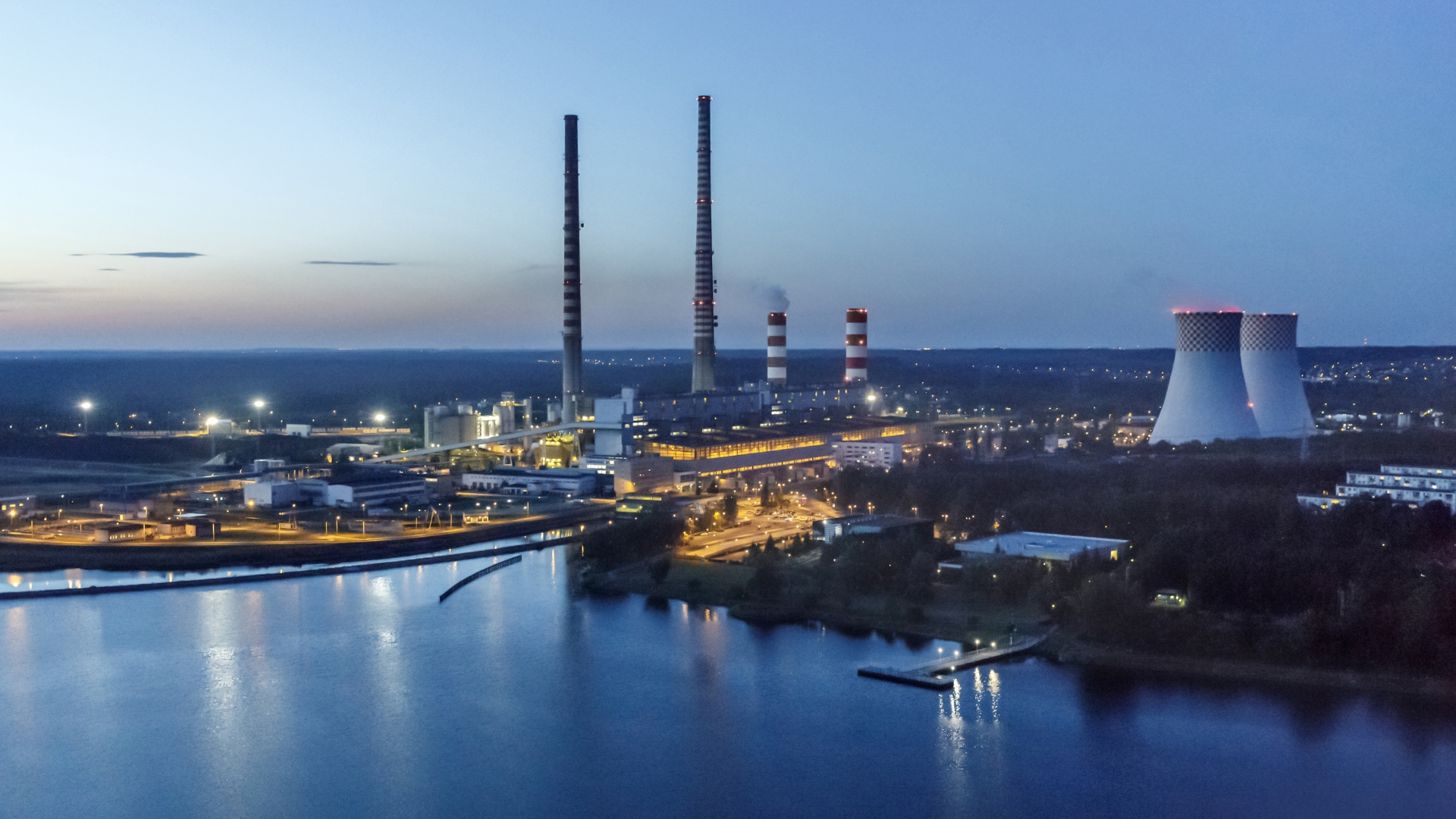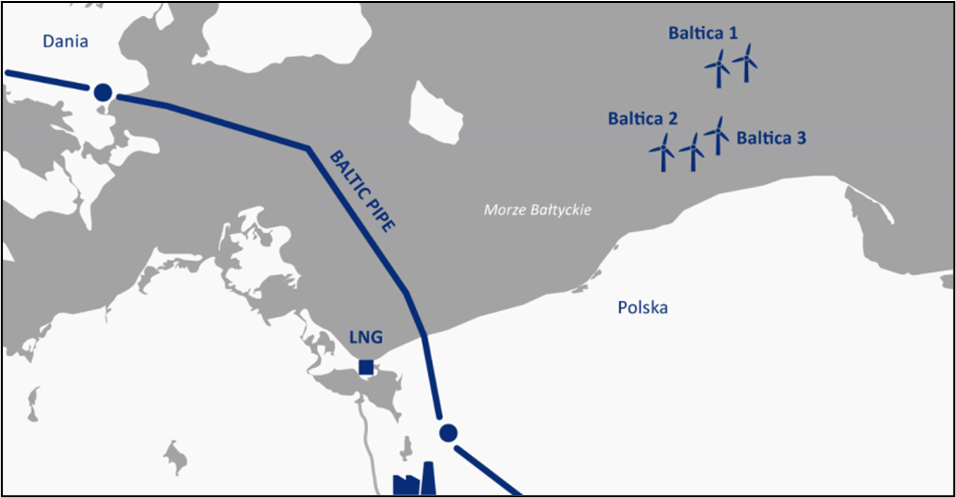
-
GC-9
The energy transition towards zero-carbon is a long-term process, especially for countries whose energy mix has relied heavily on fossil fuels - low-carbon gas capacity is an important step in this process.
As part of the strategic objective of achieving zero-carbon in 2050, a transition period is assumed in which low-carbon natural gas, among other fuels, will be used.



Investments in gas-fired capacities are part of PGE Group’s strategy and result from the need to balance the system with the growing role of RES and a shortage of flexible generating capacity in Poland.
In its future business model, PGE Group envisages a dedicated low-carbon energy segment. Capacity in the segment will come from two investment projects currently in progress: the construction of gas-fired units (PGE Gryfino 2050) and the construction of a new low-carbon unit at the Rybnik power plant.
The two gas-steam units at the Dolna Power plant (project Gryfino 2050) – each with a gross capacity of 683 MW – are a project of strategic importance to the Polish economy. The contract for the investment was signed with General Electric Global Services GmbH, Polimex Mostostal S.A. and General Electric International Inc in January 2020.
The value of the contract is PLN 3.7 billion net and the value of the 12-year maintenance contract is over PLN 1 billion. The units under construction will constitute the largest and most modern gas-fired power plant in Poland. The investment will be commissioned in 2024 and the new units, powered by low-carbon gas, will replace coal-fired capacity that is being phased out, contributing to the gradual decarbonisation of electricity generation in Poland.
A 17-year contract in the main auction of the capacity market, which will take effect from 2024, is secured for the capacities of the new Dolna Odra plant. They will meet strict environmental standards for emissions. Currently, the average emissions for power generation in the National Power System is around 0.8 tonnes CO2/MWh.
In the new units, the emissions will be below 0.35 tonnes of CO2/MWh. The commissioning of the new units will therefore reduce emissions by approx. 2-3 million tonnes of CO2 per year.
The new units will produce electricity equivalent to the demand of some 2.5 million households.
The construction of two new gas-fired units will restore the generation potential of the Dolna Odra plant.
The investment in modern gas-fired plants is a guarantee of the long-term operation of the power plant, which plays a strategic role in the National Power System as the only system generator for the north-western area of Poland.
The location of the new units will make it possible to take advantage of the potential for gaseous fuel supplies from the nearby LNG terminal in Świnoujście and to exploit the potential of the Baltic Pipe, which is expected to be put into service in the second half of 2022. Connection to the gas network will be ensured through an agreement with GAZ-SYSTEM concluded in March 2020. The investment involves the construction of approx. 63 km of gas pipeline and a gas station.
In 2022 the key elements of the engine room of unit 9 and unit 10 were placed on foundations, and assembly work of the entire turbine set was in progress, inter alia steam turbine in block 9 was connected with a generator.
At the beginning of December 2022, voltage tests for the generators were successfully completed, in January 2023 deliveries of gas compressors were made, further pressure tests of the boilers were carried out, and cabling began. The installation of the HRSG boiler of unit 9 was completed in February 2023. As regards the construction of the gas connection – assemblies are underway – approx. 90% of the gas pipeline route has been completed.
The material advancement of the project at the end of the first quarter of 2023 was more than 90%.
Construction of a new gas unit at Rybnik
On February 9, 2023 PGE Polska Grupa Energetyczna signed an agreement with syndicate of Polimex Mostostal S.A., Siemens Energy sp. z o.o. and Siemens Energy Global GmbH & Co. KG for realisation of CCGT unit with a gross capacity of 882 MW in Rybnik with a value of PLN 3 million net. The order also includes a LTSA worth approx. PLN 0.8 billion net. The project’s capital expenditures will be partly – in the amount of approximately PLN 0.88 billion – financed from funds raised through PGE Polska Grupa Energetyczna’s Series E share issue, which took place in the first half of 2022.
The new gas-fired unit in Rybnik will replace four coal-fired units planned for decommissioning with a total capacity of 900 MW at the existing Rybnik Power Plant. The unit is scheduled to be commissioned in December 2026.
The gas-steam unit in Rybnik will be the largest and most efficient unit of this type in Poland and one of the largest in Europe. The investment will meet the most stringent emission limits resulting from the BAT conclusions for gas-steam units. Emissions of particulates matter and sulphur oxides will be reduced almost to zero, which will significantly affect air quality in the Rybnik region. The emission factor of the new unit is three times lower than for 200 MW class coal-fired units, and amounts to 320 g of CO2 per kWh of electricity generated.
The new gas-steam unit will have the possibility of co-firing hydrogen in gas fuel. The unit will be cooled in an open system, i.e. with water from the Rybnik Reservoir, which will have a positive impact on the existing ecosystem. The technological solutions applied will ensure compliance with the assumptions of a closed-cycle economy.
In December 2022, the Rybnik unit was awarded a 17-year capacity contract in the main capacity market auction, which will take effect from 2027.
The agreement signed in Rybnik marks the start of one of the largest and most modern energy investments in Silesia. The gas-steam unit, which will be built in less than four years in Rybnik, will contribute to reducing the carbon intensity of the national economy and thus improving air quality in the region. It will also bring concrete savings on the purchase of CO2 emission allowances in the PGE Group. At the same time, the new investment will strengthen Poland's energy security and provide a stable energy supply for about 2 million households and new jobs both during construction and subsequent operation. This is a concrete development impulse for the region, which is particularly important for us in the current economic situation and in view of the energy transition.
The low-carbon 882 MW CCGT unit in Rybnik power plant is well-aligned with the decarbonisation of the energy sector.
- Rebuilding generation capacity in Rybnik
- Low-carbon unit, balancing increasing RES capacities
- Meeting the requirements for a low-carbon unit (BAT conclusions)
- Lower environmental risk – a unit that can be adapted to stricter environmental requirements in the future
- Just transition – Ensuring jobs at the new unit
- Gas units have lower CO2 emissions than coal units and therefore lower exposure to changes in the price of emission allowances
*Emissions for the coal-fired unit


